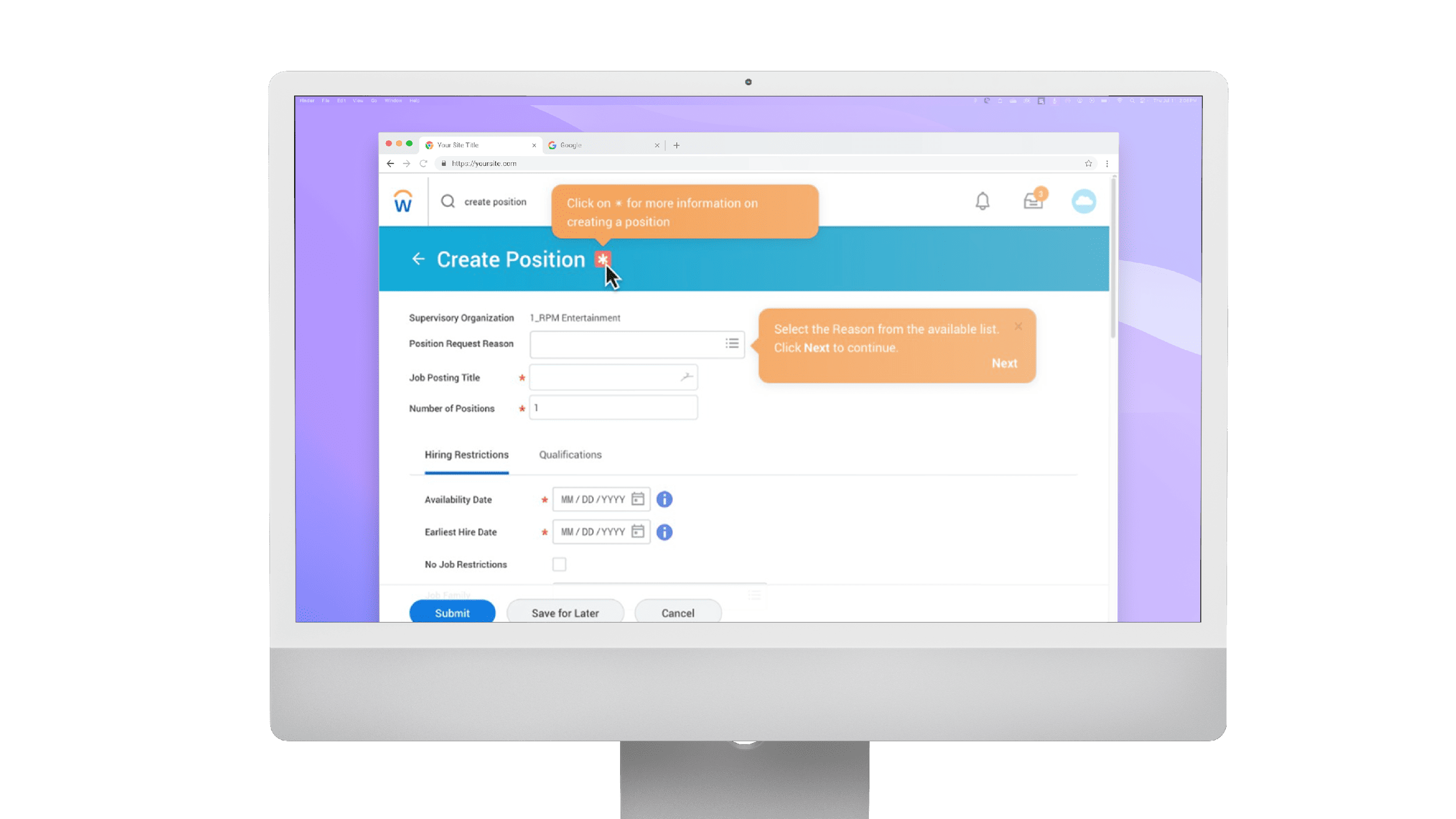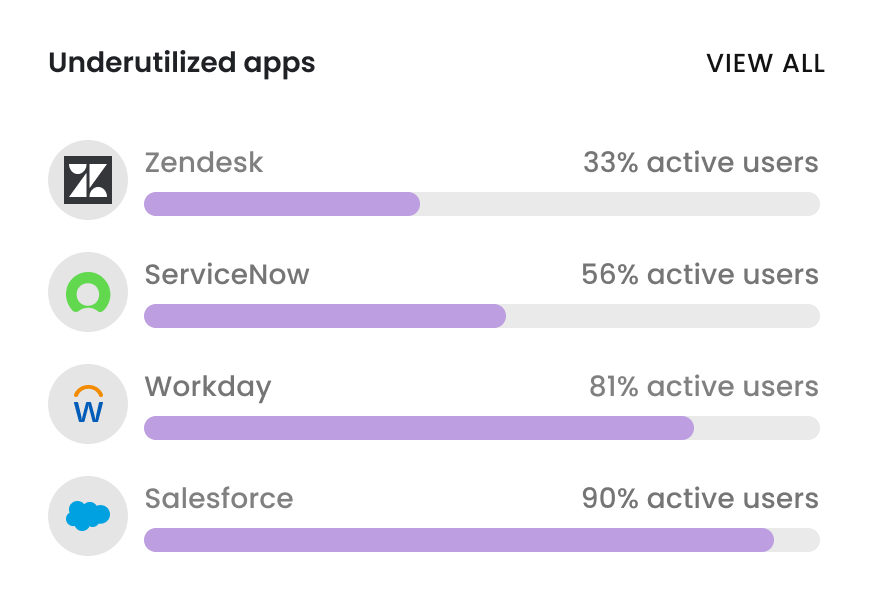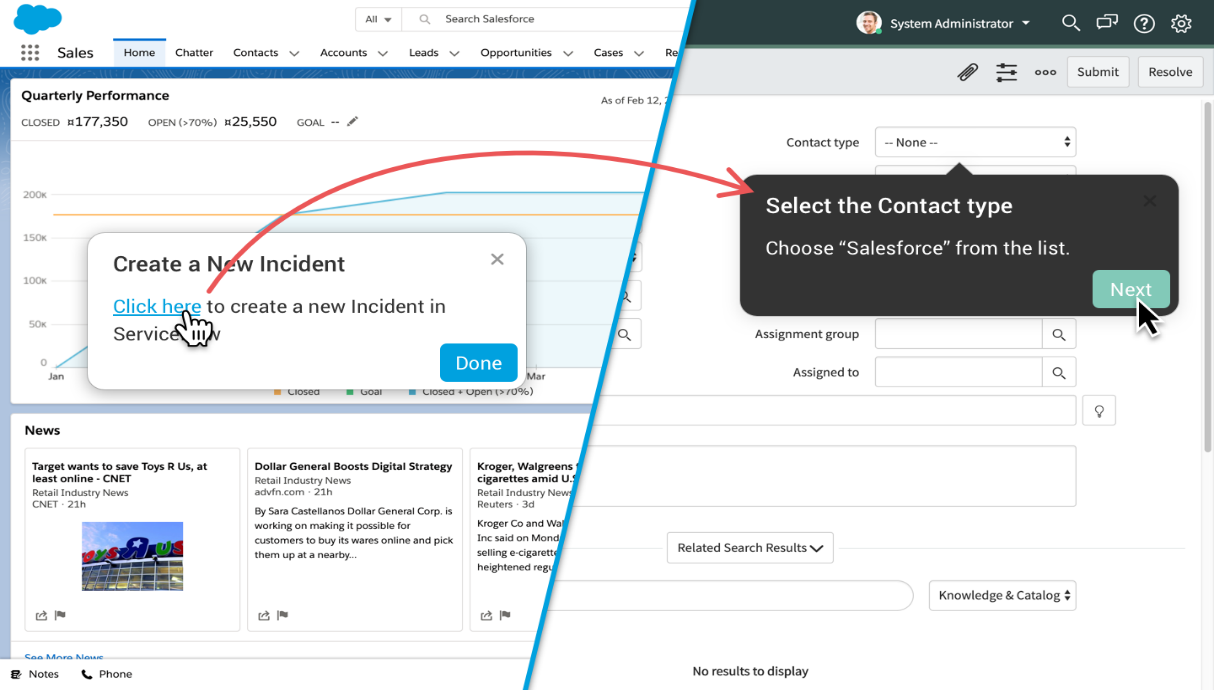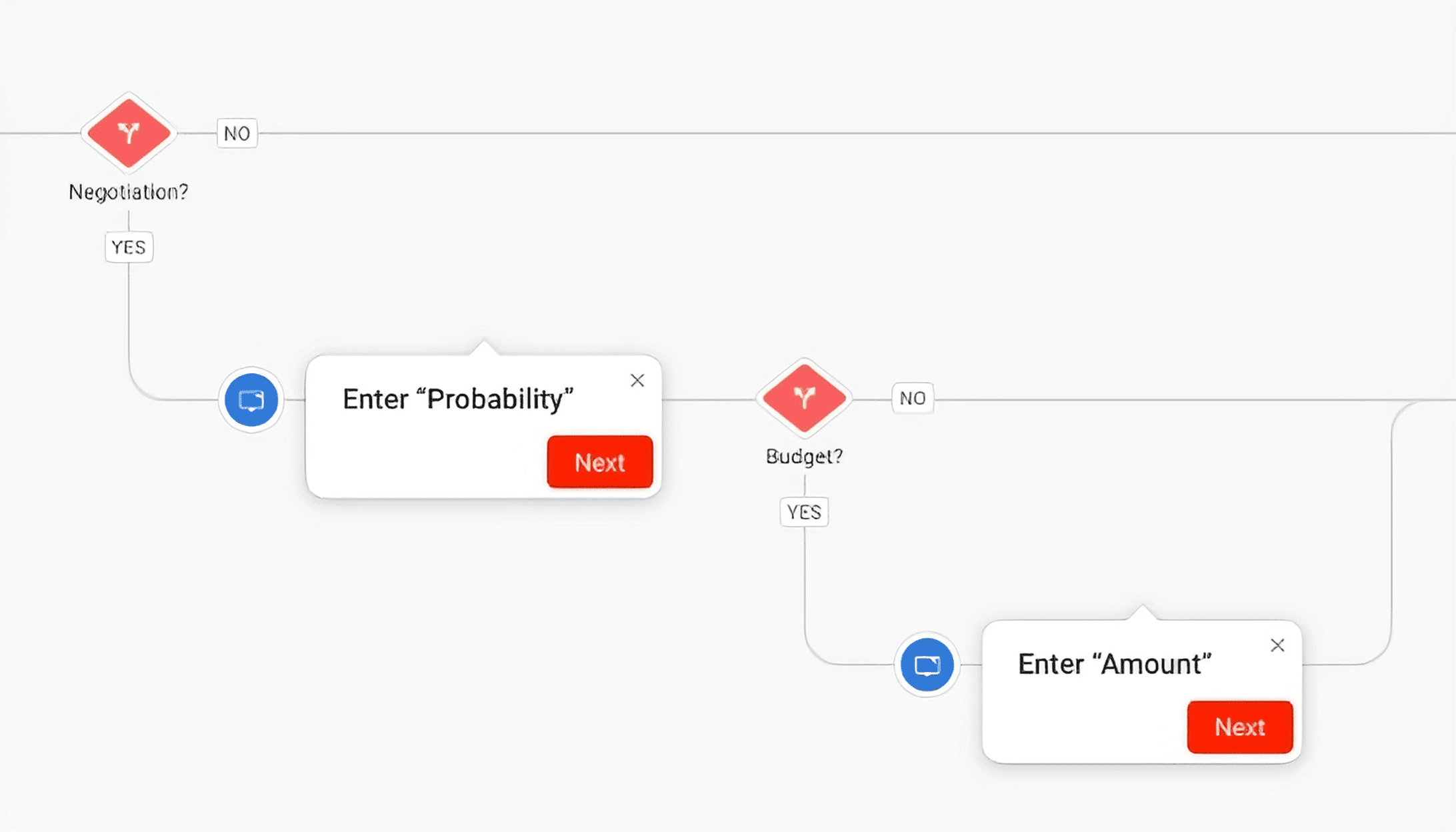Table of Contents
- The Digital Adoption Challenge: Why Implementation Isn’t Enough
- Understanding AI-Powered Digital Adoption Platforms (DAPs)
- Maximizing Software ROI with AI-Powered Digital Adoption Platforms (DAPs)
- Strategic Implementation of AI-Powered Digital Adoption Platforms
- Best Practices for Sustained Digital Adoption Success
- Common Pitfalls to Avoid in Digital Adoption
- FAQs
Imagine buying a state-of-the-art machine, only to have it sit idle in your warehouse, gathering dust. That’s the reality for many organizations when it comes to enterprise software. Despite the huge financial investment, the majority of software purchases fail to deliver on their promise, simply because users aren’t fully utilizing them.
The truth is, software implementation alone isn’t enough. Without the right tools to help employees seamlessly integrate these systems into their workflows, companies miss out on the real value. From inefficiencies to frustrated employees, the gap between deploying technology and achieving adoption becomes a costly one.
This is where Digital Adoption Platforms (DAPs) revolutionize the game. DAPs don’t just train users—they make them proficient right within the applications they use every day. This guide dives into how DAPs can turn underutilized software into a true business asset, ensuring your organization maximizes its software investment and drives real, measurable business outcomes.
The Digital Adoption Challenge: Why Implementation Isn’t Enough
You’ve probably seen the cycle before: a major investment in enterprise software, a complex implementation process, and then… disappointment. The expected benefits simply don’t materialize. The problem isn’t the technology—it’s a fundamental misunderstanding between software implementation and true user adoption. This disconnect fuels a hidden “digital adoption crisis” that silently drains resources and hinders progress.
The Real Problem: The Implementation-Adoption Gap
While implementation focuses on the technical aspects—getting the software up and running—adoption is all about people. It’s about ensuring users can effectively integrate the software into their daily workflows to improve performance and contribute to business goals. Simply installing software doesn’t guarantee it will be used correctly, consistently, or to its fullest potential. This gap is where value leaks out, often unnoticed until the consequences become glaringly obvious.
The Hidden Costs of Poor Adoption
The impact of poor software adoption extends far beyond immediate frustration. Here’s how it adds up:
- Financial Drain: Organizations waste millions on unused or underutilized software licenses, paying for technology that isn’t delivering value.
- Productivity Loss: Employees waste valuable hours navigating complex interfaces, searching for help, or developing inefficient workarounds.
- Increased Errors: Improper software usage leads to mistakes, which can affect data quality, compliance, and even customer satisfaction.
- Rising IT Support Burden: IT teams are overwhelmed with repetitive “how-to” questions, diverting resources away from more strategic initiatives.
- Employee Disengagement: Persistent struggles with technology lead to frustration and resistance to future change, harming morale and hindering digital transformation efforts.
Why Traditional Training Isn’t Enough
Many organizations attempt to bridge this gap with traditional training methods like classroom sessions or static help manuals. Unfortunately, these methods often fall short because:
- Training Outside Workflows: The Ebbinghaus forgetting curve shows that up to 90% of training is forgotten within a week if it’s not embedded in daily work.
- Generic, One-Size-Fits-All Content: Traditional training methods fail to address the specific needs of different user roles or evolving business processes.
- Inability to Keep Up with Changes: Static resources can’t adapt quickly enough to ongoing software updates or shifting business priorities.
The Solution: Embedding Support Where It’s Needed
To overcome the digital adoption challenge, it’s essential to move beyond outdated training methods. The key is to embed support and guidance directly into the user experience, providing real-time, contextual help when users need it most.
Is Your Team Just Using Software—or Actually Adopting It?
Learn how Apty ensures your employees go beyond surface-level usage to true digital adoption.
See How Apty Makes It Happen
Understanding AI-Powered Digital Adoption Platforms (DAPs)
To close the gap between software implementation and full adoption, organizations need tools specifically designed to boost user proficiency and ensure software is used effectively within the workflow. AI-infused Digital Adoption Platforms (DAPs) have emerged as the definitive solution, marking a critical shift from traditional training methods towards continuous, contextual enablement that drives tangible results.
What is an AI-Powered DAP?
At their core, AI-powered DAPs act as software layers that integrate seamlessly with other applications—whether CRMs, ERPs, or custom tools—to provide real-time, in-application guidance, support, and automation. Unlike external training resources or help desks, AI-powered DAPs operate directly within the user’s workflow, delivering assistance precisely when and where it’s needed. This context-driven support reduces disruptions and enhances learning by enabling users to immediately apply new knowledge to their tasks.
More Than Onboarding: Achieving True Digital Adoption
While many traditional solutions focus on onboarding or simple feature tours, AI-infused DAPs go beyond that. They enable what we call “true digital adoption”—a state in which users are not just passively interacting with software, but are actively proficient, efficient, and aligned with business goals. This means moving beyond basic knowledge of features to ensuring that users understand how and why to use software effectively to achieve specific outcomes. AI-powered DAPs empower this deeper adoption by:
- Guiding users through complex processes
- Reinforcing best practices in real-time
- Validating data entry to ensure accuracy
- Automating repetitive tasks to improve efficiency
Core Capabilities of Modern AI-Powered DAPs
Modern AI-infused DAPs come equipped with a suite of powerful capabilities designed to drive adoption and enhance software usage:
- In-application guidance: Interactive walkthroughs, tooltips, and task lists that guide users step-by-step through processes, helping them learn and execute tasks seamlessly.

- Contextual help: AI-driven support that adapts to the user’s role, location within the app, and behavior, offering the most relevant information precisely when needed.
- Robust analytics: AI-powered analytics track how software is being used, identifying adoption bottlenecks, feature engagement, process completion rates, and areas where users struggle. These insights are essential for continuous improvement and tracking ROI.

- Cross-application workflows: Many AI-powered DAPs help users navigate processes that span multiple applications, ensuring seamless integration across systems and boosting productivity.

- Automation: With advanced automation capabilities, DAPs streamline repetitive tasks, reducing manual effort and enabling users to focus on higher-value activities.
- Intuitive content creation tools: No-code or low-code tools allow business users and subject matter experts to build and maintain in-app guidance without relying heavily on IT.

A Shift in Focus: From Training to Business Impact
The rise of AI-powered DAPs represents a profound shift in focus—from merely training users on software features to enabling them to achieve measurable business outcomes. By embedding guidance, analytics, and automation directly into the work environment, AI-infused DAPs transform enterprise software from a source of frustration into a powerful tool for productivity, operational efficiency, and value creation.
For any organization serious about maximizing its technology investments, an AI-powered DAP is no longer a luxury—it’s a must-have. These platforms ensure that software adoption leads to tangible results, driving ROI and unlocking the full potential of your technology stack.
Maximizing Software ROI with AI-Powered Digital Adoption Platforms (DAPs)
The ultimate objective of investing in enterprise software is clear: a strong return on investment (ROI). However, as we’ve seen, the implementation-adoption gap often prevents organizations from realizing the full value of their technology. AI-infused Digital Adoption Platforms (DAPs) directly address this challenge by ensuring that software is not only deployed but effectively utilized to drive tangible business outcomes, maximizing ROI.
The Financial Imperative for Effective Digital Adoption
When users can navigate and leverage software proficiently, the benefits ripple across the organization, translating into measurable financial gains. AI-powered DAPs act as catalysts for this value realization by addressing the core drivers of software ROI:
- Accelerated Time-to-Value: Traditional onboarding can take weeks or even months, resulting in lost productivity and delayed returns on investment. AI-powered DAPs cut this ramp-up time significantly, providing contextual, on-demand guidance that helps new hires become proficient 40-50% faster and enables existing employees to quickly adapt to new features and processes. The result? The organization starts realizing the value of its software much sooner.
- Cost Reduction: Traditional training incurs high costs—developing materials, scheduling sessions, and hiring instructors. AI-infused DAPs drastically reduce these expenses by empowering users with self-service, in-app support. This cuts down on reliance on IT help desks and reduces support ticket volumes by 25-30% for common “how-to” queries. With fewer tickets, IT can focus on more strategic tasks, driving further value for the business.
- Minimized Errors and Rework: By guiding users through workflows and ensuring proper software usage, DAPs reduce costly mistakes. Organizations report a 30% reduction in process errors, saving time and resources spent on rework and corrections. This also contributes to higher operational efficiency and reduced downtime.
Boosting Productivity Across the Board
AI-powered DAPs dramatically improve productivity by ensuring users spend less time struggling with complex software interfaces or searching for help. Here’s how:
- Streamlined Workflows: DAPs automate repetitive tasks and guide users through critical processes, reducing friction and allowing employees to focus on their core responsibilities.
- Increased Process Completion Rates: Studies show that with AI-powered guidance, process completion rates improve by up to 45%, delivering significant time savings and efficiency gains.
Improved Data Quality and Compliance
One of the most impactful ROI drivers is improved data quality and compliance:
- Guided Data Entry: AI-powered DAPs ensure that users input accurate, consistent data by providing real-time, in-app validation. This enhances the reliability of business intelligence and reduces the risk of non-compliance.
- Enforced Standardization: DAPs enforce process consistency, ensuring adherence to both internal policies and external regulations, which is crucial for minimizing risk.
Enhancing the Employee and Customer Experience
DAPs do more than improve operational efficiency—they also enhance both employee and customer experiences:
- Employee Morale and Engagement: By reducing software-related frustration, DAPs improve employee satisfaction, which can lower turnover rates and reduce the costs associated with hiring and training.
- Better Customer Service: When employees are empowered and efficient, the result is often faster response times and improved customer service, leading to higher customer satisfaction and retention.
Quantifying the Impact: Over 3x ROI in the First Year
Organizations strategically leveraging AI-powered DAPs consistently report significant ROI—sometimes achieving over 3x ROI within the first year. While the exact figures may vary, the mechanism is consistent: DAPs turn software usage from a passive task into an active driver of efficiency, cost savings, and value creation, directly boosting the ROI on substantial technology investments.
Strategic Implementation of AI-Powered Digital Adoption Platforms
Maximizing the potential of an AI-powered Digital Adoption Platform (DAP) requires more than just deployment—it demands a strategic, well-planned approach that aligns with broader business goals. Implementing a DAP isn’t just an IT project; it’s a strategic initiative aimed at changing user behavior and driving measurable business outcomes.
- Assessment and Planning
The journey begins with a comprehensive assessment of your current software landscape. Key steps include:
- Analyze Software Usage: Go beyond simple logins to assess feature utilization, process completion, and identify adoption barriers.
- Gather Feedback: Collect input from users and support teams to identify pain points and quantify the business impact (e.g., lost productivity, errors).
- Set Clear Goals: Define measurable adoption goals across user proficiency, process efficiency, and business outcomes (e.g., productivity gains, cost savings).
- Engage Stakeholders: Involve key stakeholders early—executive sponsors, business unit leaders, IT teams, and influential power users to ensure buy-in and smooth execution.
- Implementation and Enablement
Next, focus shifts to the selection and implementation of the right DAP. Key considerations include:
- Platform Selection: Choose a DAP that aligns with business outcomes, offers robust analytics, integrates seamlessly with your tech stack, and provides intuitive no-code content creation tools.
- User-Centric Content Strategy: Develop content that’s contextual, role-based, and aligned with optimized workflows to reinforce efficient processes.
- Phased Rollout: Begin with high-impact areas or pilot groups to demonstrate quick wins and drive engagement. Effective change management is crucial—clearly communicate the “why” behind the DAP and address user concerns.
- Measurement and Optimization
A DAP’s true value lies in continuous optimization. To maximize ROI:
- Track Meaningful Metrics: Move beyond basic usage stats and track adoption depth, process efficiency improvements, and impact on business KPIs.
- Analyze Data: Regularly review usage data, feedback, and performance to identify areas for improvement.
- Ongoing Refinement: Continuously optimize content, workflows, and the adoption strategy based on insights. Establish governance for content maintenance and updates to keep the DAP relevant as business needs evolve.
Aligning with Business Goals
Throughout the process, ensure the DAP strategy aligns with your broader digital transformation goals. By viewing the DAP as a strategic enabler of business outcomes, organizations can bridge the adoption gap and transform software investments into significant, sustainable value.
Best Practices for Sustained Digital Adoption Success
Achieving initial adoption is just the start. To continuously derive value from a Digital Adoption Platform (DAP) and ensure long-term success, organizations must focus on key best practices. Here are the critical factors for sustaining digital adoption momentum:
- Executive Sponsorship and Governance
- Leadership Support: Executive sponsors play a crucial role in championing the DAP initiative, securing resources, and emphasizing its strategic importance.
- Clear Governance: Establishing clear governance structures ensures ownership, decision-making processes, and accountability for managing the DAP and its content.
- User-Centric Approach
- Understand User Needs: A deep understanding of user workflows and pain points is essential. Gather feedback to shape content and guidance around real user needs.
- Ongoing Feedback Loops: Regular feedback mechanisms keep the strategy aligned with evolving user needs, ensuring continued relevance and engagement.
- Effective Content Strategy
- Quality, Relevant Content: Craft content that’s concise, actionable, and aligned with user tasks, using familiar language. Test it with real users before deployment.
- Modular Design & Governance: Use a modular approach for easier maintenance and ensure robust governance to maintain content quality and relevance through regular updates.
- Robust Change Management
- Compelling Narrative: Communicate the benefits of adoption through a clear “WIIFM” (What’s In It For Me) message.
- Internal Champions: Build a network of champions to drive adoption and address resistance proactively.
- Reinforce Desired Behaviors: Consistently reinforce the right behaviors with recognition and leadership messaging.
- Data-Driven Optimization
- Track Impactful Metrics: Go beyond basic usage stats—measure guidance effectiveness, process completion rates, error reductions, and business outcomes.
- Continuous Improvement: Use data insights to refine content, identify struggles, and optimize processes. This transforms adoption into a dynamic, evolving capability.
Common Pitfalls to Avoid in Digital Adoption
Several common pitfalls can derail digital adoption efforts. Avoiding these mistakes ensures a smoother, more successful implementation:
- Technology-First Thinking
- Pitfall: Focusing on DAP features rather than addressing the underlying business challenges or desired outcomes.
- Avoidance: Begin with business goals and work backward to define the technology requirements.
- Inadequate Content Strategy
- Pitfall: Underestimating the effort needed to create and maintain high-quality, relevant guidance, leading to outdated or ineffective content.
- Avoidance: Allocate dedicated resources and establish strong content governance from the start.
- Overlooking Change Management
- Pitfall: Treating DAP implementation as a tech project and neglecting the behavioral changes required for adoption.
- Avoidance: Integrate change management principles throughout the entire adoption process.
- Lack of Integration
- Pitfall: Implementing the DAP in isolation, without connecting it to existing systems (e.g., LMS, ITSM, or knowledge bases), creates a disjointed experience.
- Avoidance: Map the user support ecosystem early and plan for seamless integration.
- Treating It as a Project, Not a Program
- Pitfall: Viewing adoption as a one-time project rather than an ongoing process of optimization and value realization.
- Avoidance: Establish long-term ownership, governance, and continuous improvement cycles.
By embracing best practices and avoiding these common pitfalls, organizations can ensure their digital adoption efforts provide sustained value, embedding effective software use into the organization’s core operations.
Conclusion: Transforming Digital Adoption into Business Success
The true value of enterprise software lies not in its deployment but in its effective adoption. The gap between implementation and adoption drains resources and hinders digital transformation, preventing organizations from realizing full ROI.
AI-powered Digital Adoption Platforms (DAPs) like Apty address this by providing contextual, in-application guidance, analytics, and automation. DAPs empower users within their workflows, ensuring proficiency and aligning software use with business outcomes.
Success requires a strategic approach: assess current usage, set clear business-aligned goals, select the right platform, create user-centric content, manage change effectively, and continuously optimize. Avoiding common pitfalls, like technology-first thinking and poor content governance, is key to sustained adoption.
Organizations that prioritize digital adoption gain a competitive edge, turning technology investments into measurable business success. It’s time to move beyond implementation and embrace a holistic, outcome-driven approach to unlock the full potential of your digital tools.
FAQs
- Accelerated Time-to-Value: Users (especially new hires) become proficient faster, reducing onboarding time and allowing the organization to realize software benefits sooner.
- Reduced Costs: DAPs lower traditional training expenses and significantly decrease IT support tickets by enabling user self-service.
- Increased Productivity: By providing instant guidance and streamlining workflows, DAPs minimize the time users spend struggling with software, allowing them to focus on core tasks.
- Improved Data Quality & Compliance: Guided workflows and validation help reduce errors and ensure users follow standard processes and policies.
- Enhanced Employee Experience: Reducing software frustration improves morale and engagement.
- Assessment & Planning: Understanding current adoption levels, pain points, and setting clear, business-aligned goals.
- Strategic Platform Selection: Choosing a DAP based on business outcomes, analytics, integration, and ease of content creation.
- Implementation & Enablement: Rolling out the DAP, often starting with pilot groups, and developing a user-centric content strategy.
- Change Management: Communicating the value, addressing user concerns, and fostering buy-in.
- Measurement & Optimization: Continuously analyzing usage data and feedback to refine guidance and strategy. Treating it solely as an IT installation often leads to failure.
- Strong Governance & Sponsorship: Clear ownership and visible leadership support are crucial.
- User-Centricity: Continuously understanding and addressing user needs and workflows.
- Robust Content Strategy: Dedicating resources to create, maintain, and govern high-quality, relevant guidance content.
- Effective Change Management: Consistently reinforcing the value and managing the human aspects of adoption.
- Data-Driven Optimization: Regularly using DAP analytics to measure impact, identify issues, and continuously improve content and processes. It should be treated as an ongoing program, not a one-time project.
